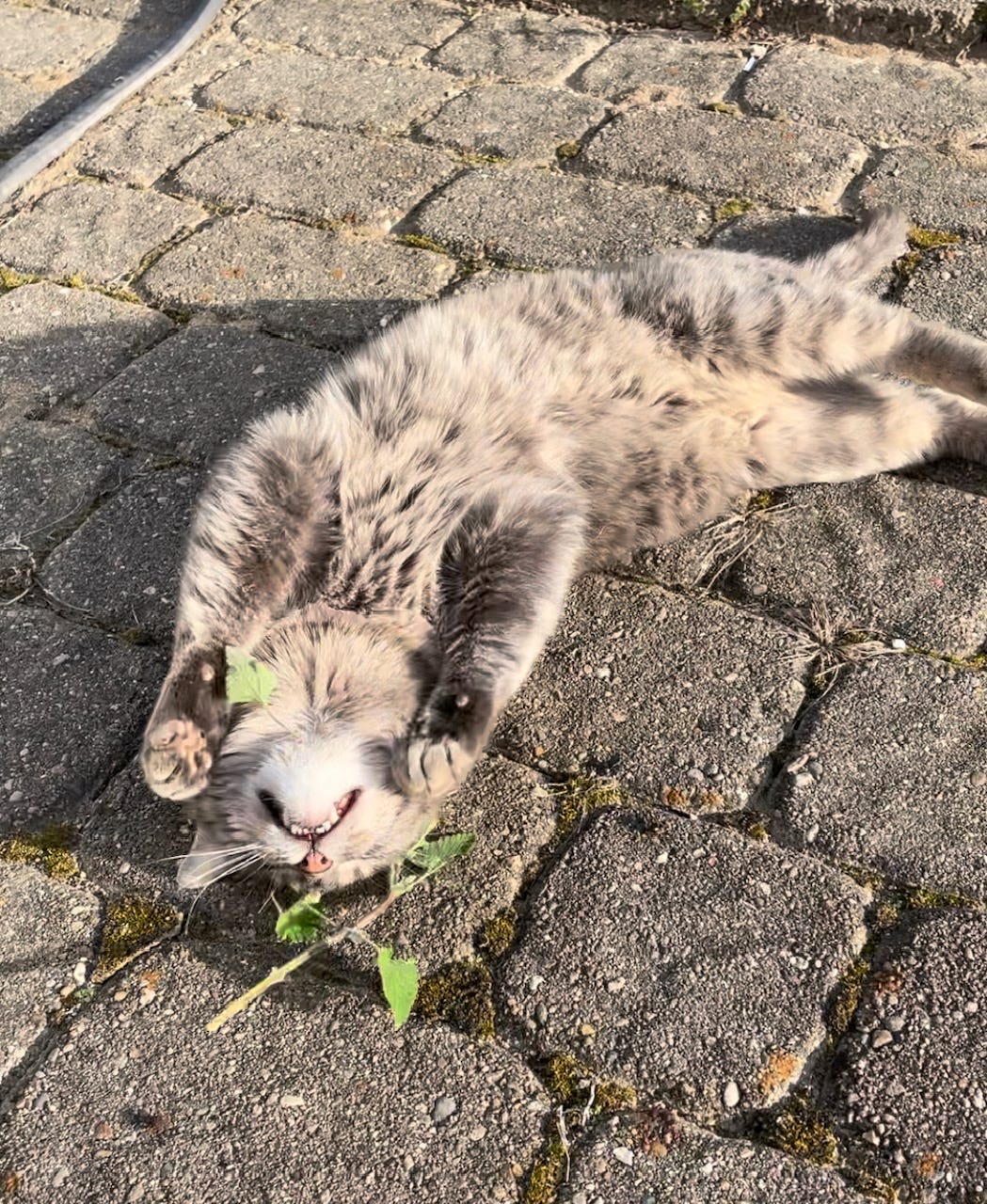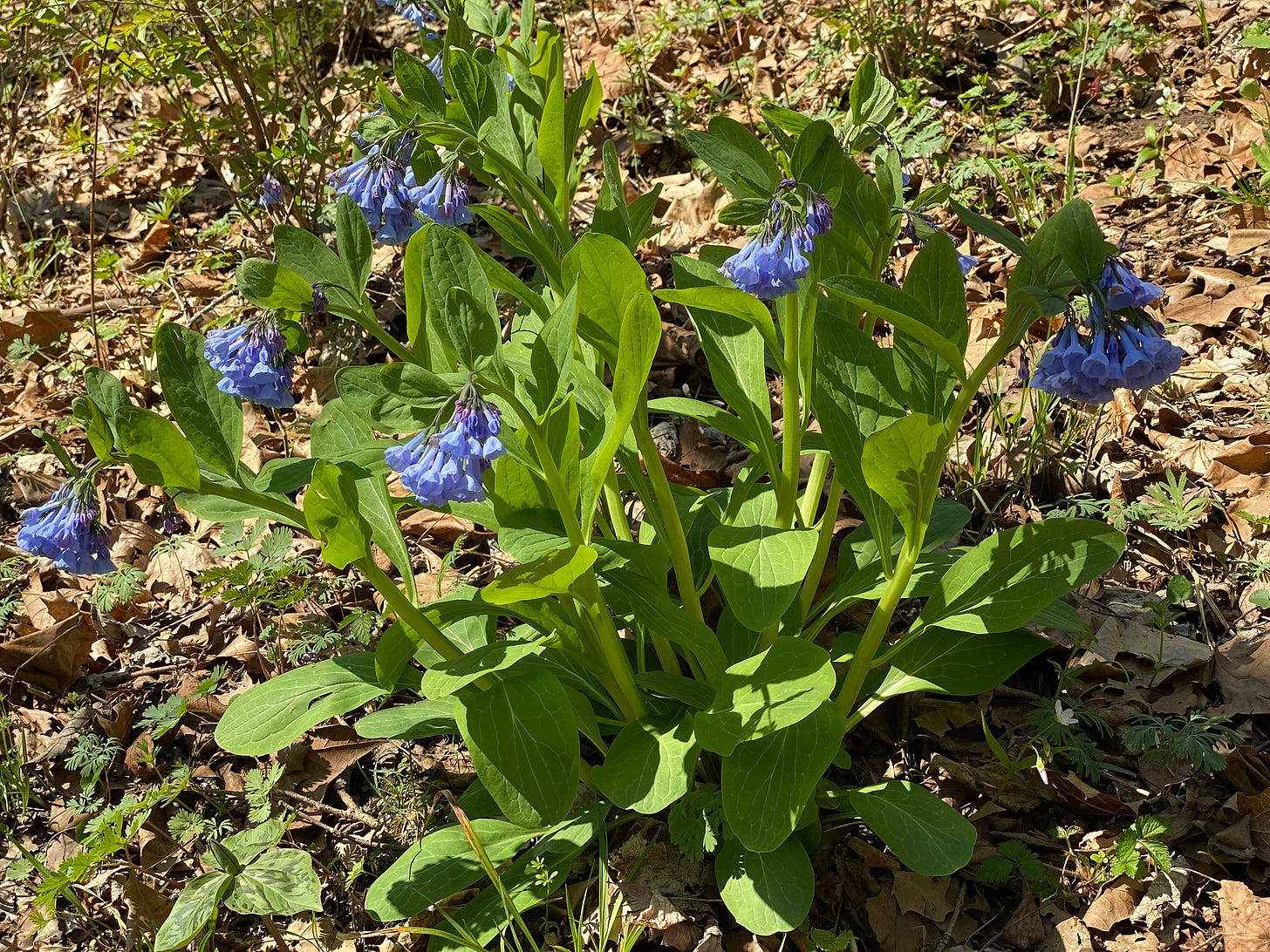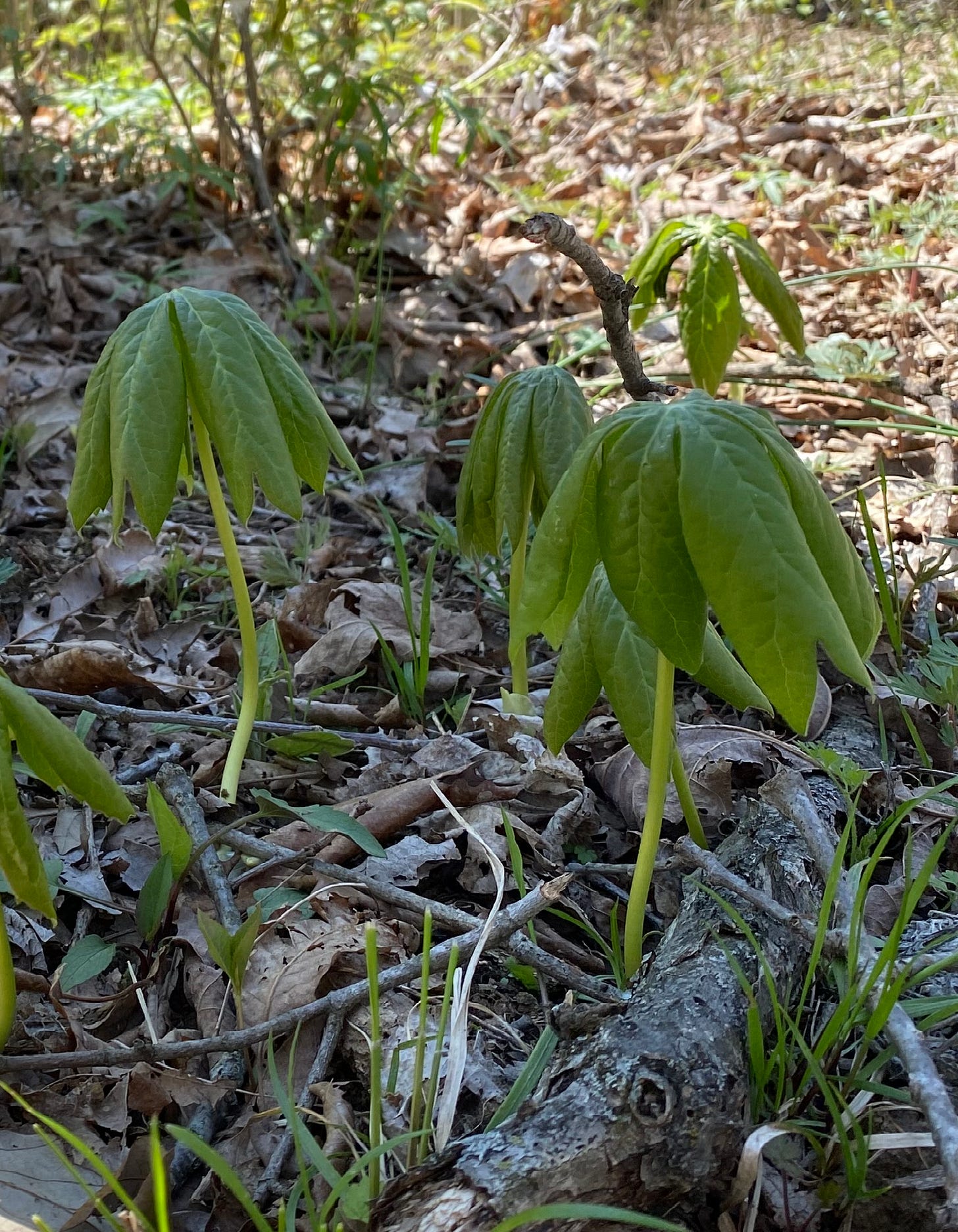Catnip 3 and What Else is Growing at Weedom
Uplifting to rats, relaxing for us
It Catnip 1 we covered plant identification and an overview of the botany and the uses of this weed. Catnip 2 delved deeper into plant chemistry, particularly the essential oil constituents, the insect repellent and antimicrobial properties. Now we will finish up with some more uses of the the herb, and follow it with a bonus tour of a some local wild plants which pop up in the early spring.
Plant chemistry can have this effect on people…..
Most Catnip research has been done on the essential oils, but there are other important constituents. Catnip, being mostly water, will dry down to about 15% of its harvested weight. It contains significant amounts of potassium, on the order of that found in kiwi fruit, and a fair amount of calcium and magnesium. Methanol, a more polar solvent, extracts the phenolic compounds and, among them, the flavonoids more efficiently than straight ethanol, yielding on the order of 1.4% total phenolics and 0.5% flavonoids from the dried herb, so think of tincturing catnip with vodka (40-50%) rather than Everclear (95%) ethanol, when you’re seeking these compounds. Among these substances are those which contribute to antimicrobial, anti-inflammatory, anti-cancer, cardioprotective, and nervine activity observed in catnip. Some compounds of note are α-amyrin, stigmasterol, chlorogenic acid, rosemarinic acid, squalene, β-sitoserol, chichoric acid, campesterol, caffeic acid, coumaric acid, caffeoylquinic acid, and various derivatives of quercetin, apigenin, luteolin, and acacitine.
Catnip excites the cats, and it seems to be a little like Viagra for rats. One might ask: Who needs that??? There’s always a silver lining for someone. The breeders who raise Sprague-Dawley rats might be excited about this. Apparently spiking the rat food with 10% Nepeta cataria leaves caused increased quality of erections in these animals, and some increase in sexual behavior, but a general decrease in overall activity. Effects on dopaminergic pathways were suggested as a possible mechanism for the enhancement of male rats sex performance, but it seems more likely that the papaverine-like inhibition of phosphodiesterase might have something to do with the erection enhancement. (Does this bring to mind the old papaverine and phentolamine injections that preceded the introduction of Viagra?) The catnip mode of action was demonstrated in vitro using guinea pig trachea model of smooth muscle. Catnip essential oil has also been shown to inhibit smooth muscle contraction in other models such as rabbit jejunum. These activities point to the mechanisms of action underlying the traditional uses of catnip in the treatment of colic, cough, diarrhea, and asthma, all of which involve reducing smooth muscle contractility.
Both essential oils and non volatile constituents of catnip have been studied for anti-inflammatory activity, as well as anti-nociceptive effects (reducing nervous system response to pain and noxious stimuli ). Reduced tail withdrawal response, and reduced abdominal constriction response to acetic acid in mice were evidence of the anti-nociceptive effect. This is similar to the type of analgesia that opioid compounds produce. At very low doses, the essential oil of Nepeta cataria reduced the swelling and inflammation produced by carrageenan injection in mice. The methanol extract has been shown to inhibit the production of nitric oxide, an important mediator of inflammation and immune response. Inhibition of calcineurin by caffaoyl phenylethanoid glycosides from Nepeta cataria has been seen as another possible mechanism for immune modulation and anti-inflammatory effects. Given that calcineurin mediates so much activity as well as neurotransmitter secretion and reuptake in the brain, this mechanism might contribute to nervine and many other activities of the plant.
An ethanolic extract of catnip put chicks into light sleep at lower doses, (25-1800mg/kg) and this effect was reduced at higher doses, above 2 grams/kg. Mice given catnip leaves in food, or treated with a non polar solvent extract of catnip have been subjected to the (nasty) behavioral despair test. The treated mice exhibit a longer time to reach immobility, which has been classically considered to suggest antidepressant activity. So, during the times when chocolate is not enough, one could think about eating catnip whole, or using a tincture made with Everclear, 95% ethanol.
Non volatile constituents, rosemarinic acid, luteolin, caffeic acid found in Nepeta cataria account prominently for its antioxidant activity.
Both the methanol extract and essential oil of catnip has shown protective potential for the liver. The essential oil, obtained by supercritical fluid extraction mitigated liver damage by acetaminophen. By modulating numerous enzymes, it inhibited the formation of toxic intermediates of acetaminophen, and accelerated the formation of harmless metabolites. In a model of liver DNA damage by carbon tetrachloride, the harm was shown to be greatly decreased by treatment with a methanol extract of catnip.
Catnip is regarded in traditional Chinese medicine as an anti-cancer agent. A group flavonoid compounds from Nepeta cataria, including diosmetin, apigenin, luteolin, hesperidin, icynaroside, and quercitrin, are collectively called TFS. These were found in vitro to promote apoptosis and inhibit cell proliferation of human lung cancer cell line A549, by disrupting microRNA-126, and by modulating the PI3K-AKT signaling pathway. Essential oils of Nepeta cataria also showed in vitro cytotoxic potential against keratinocytes and bronchial epithelial cells at low concentrations of 0-0012-0.015% v/v.
There’s plenty more where that came from, but it’s time to arise from the fog of catnip research, and tour some of the ephemeral Spring plants that have popped up at Weedom.
Starting off with the Virginia Blue Bells down by the creek bed. These are in the Boraginaceae (borage) family. They’re not the same as the blue bells of the UK (Hyacinthoides). Virginia blue bells are 2 or 2.5 feet tall, and remind us a bit of borage but entirely without the hairs. Blue bells like partial shade, and moist woodland areas. Ours are down by the creek at the north west end of the property.
Dutchman’s breeches, Dicentra cucullaria (family Papaveraceae) showed up in bulk on the north facing hillsides in our woods. Only a few of the plants are in bloom right now, but they look great. The flowers are white with yellow trim, but in some places you can see pinkish flowers. They’re the same species. Isoquinolone alkaloids in this plant are a bit toxic. You might have vomiting, diarrhea and maybe convulsions if you eat any parts of this plant.
Cutleaf toothwort, Cardamine concatenata, aka Dentaria lacinata, is a member of the mustard family, Brassicaceae. So you can eat the leaves and roots. It tastes like horseradish. The root is a hotter form of horseradish. It’s rather small and you might not want to kill these plants off by grabbing a lot of roots. Another relative, Cardimine diphylla has larger edible roots.
Mayapple, Podophyllum peltatum (family Berberidaceae) is another understory plant found in the woods. It forms a single flower under the conjoined leaf. Eventually that turns into a single fruit, which could be eaten, but only when totally ripe, and a golden color. The podophyllotoxin, or podophyllin in the rest of the plant is too poisonous. Don’t eat it. Symptoms include salivation, vomiting, diarrhea, excitement, headache, fever, lethargy, and perhaps coma. Contact dermatitis is possible when handling the plant.
Toadshade or wood lily, Trillium species (family Liliaceae) The stem extends from the rhizome and has tiny scaly leaves called cataphylls. The three leaf like things you see are really bracts of the flower, which has not yet opened. We have plenty of them on the north facing hills in the woods, but none fully flowered yet. Trilliums are long lived plants, and take a long time to produce blooms. Fruits and rhizomes are considered mildly poisonous to humans.
Spring beauty, Claytonia virginica grow throughout the woods and fields in early spring. They’re maybe 4-5 inches tall, with tiny flowers, up to a half inch when fully spread. They’re being reclassified from the family Portulacaceae to the miners lettuce family, Montiaceae, and that probably got someone a masters degree. These plants and the little bulb below the ground are edible. The bulb is too tiny, so don’t bother, and let the plant regrow again.
Hope you can spot some of these, and more when you’re wandering around outside. Happy Spring!
Where We Dig:
1. Murai F, Tagawa M, Damtoft S, Jensen SR, Nielsen BJ. (1R, 5R, 8S, 9S)-Deoxyloganic Acid from Nepeta cataria. Chemical & Pharmaceutical Bulletin. 1984;32(7):2809-2814. doi:10.1248/cpb.32.2809
2. Saraf J, Bhattacharya P, Kalia K, et al. A Friend or Foe: Calcineurin across the Gamut of Neurological Disorders. ACS Cent Sci. 2018;4(7):805-819. doi:10.1021/acscentsci.8b00230
3. S. S, Shabaraya A. A REVIEW ON PHARMACOLOGICAL ACTIVTIES OF ESSENTIAL OIL IN NEPETA CATARIA. Published online May 10, 2019.
4. Can You Smoke Catnip? Effects And Benefits | Smokable Herbs. Published April 30, 2020. Accessed March 23, 2023. https://www.smokableherbs.com/catnip/
5. Catnip (also Nepeta cataria) : Erowid Exp: Main Index. Accessed March 29, 2023. https://www.erowid.org/experiences/subs/exp_Catnip.shtml#Retrospective_/_Summary
6. Ibrahim Z, Qayssar R, Sardar S, et al. Catnip (Nepeta cataria L.): Recent Advances in Pharmacognosy, Cultivation, Chemical Composition and Biological Activity. Journal of Drug Delivery and Therapeutics. 2022;12:254-263. doi:10.22270/jddt.v12i4-S.5559
7. Grognet J. Catnip: Its uses and effects, past and present. Can Vet J. 1990;31(6):455-456.
8. Zomorodian K, Saharkhiz MJ, Shariati S, Pakshir K, Rahimi MJ, Khashei R. Chemical Composition and Antimicrobial Activities of Essential Oils from Nepeta cataria L. against Common Causes of Food-Borne Infections. International Scholarly Research Notices. 2012;2012:e591953. doi:10.5402/2012/591953
9. Joshi M, . H, Kumar R, Prakash O, Pant A, Rawat D. Chemical composition and biological activities of Nepeta hindostana (Roth) Haines, Nepeta graciliflora Benth. and Nepeta cataria L. from India. 2021;12:35-46.
10. Gilani AH, Shah AJ, Zubair A, et al. Chemical composition and mechanisms underlying the spasmolytic and bronchodilatory properties of the essential oil of Nepeta cataria L. Journal of Ethnopharmacology. 2009;121(3):405-411. doi:10.1016/j.jep.2008.11.004
11. Different Catnip Plants – Information On Common Varieties Of Catnip. Gardening Know How. Published March 4, 2021. Accessed March 28, 2023. https://www.gardeningknowhow.com/edible/herbs/catnip/catnip-plant-varieties.htm
12. Prescott TAK, Veitch NC, Simmonds MSJ. Direct inhibition of calcineurin by caffeoyl phenylethanoid glycosides from Teucrium chamaedrys and Nepeta cataria. J Ethnopharmacol. 2011;137(3):1306-1310. doi:10.1016/j.jep.2011.07.063
13. Uenoyama R, Miyazaki T, Adachi M, Nishikawa T, Hurst JL, Miyazaki M. Domestic cat damage to plant leaves containing iridoids enhances chemical repellency to pests. iScience. 2022;25(7):104455. doi:10.1016/j.isci.2022.104455
14. Zhu JJ, Zeng XP, Berkebile D, Du HJ, Tong Y, Qian K. Efficacy and safety of catnip (Nepeta cataria) as a novel filth fly repellent. Med Vet Entomol. 2009;23(3):209-216. doi:10.1111/j.1365-2915.2009.00809.x
15. Tisserand R, Young R. Essential Oil Safety: A Guide for Health Care Professionals. Second edition. Elsevier Ltd; 2013.
16. Everything You Need to Know About Nepeta Cataria. Accessed March 22, 2023. https://nepetacataria.org/
17. Chauhan KR, Klun JA, Debboun M, Kramer M. Feeding deterrent effects of catnip oil components compared with two synthetic amides against Aedes aegypti. J Med Entomol. 2005;42(4):643-646. doi:10.1603/0022-2585(2005)042[0643:fdeoco]2.0.co;2
18. Ganora L. Herbal Constituents, 2nd Edition - Foundations of Phytochemistry. Lulu Press, Inc.; 2021. https://openlibrary.org/books/OL35083771M/Herbal_Constituents_2nd_Edition
19. Hutchens AR. Indian Herbalogy of North America. Shambhala; Distributed in the United States by Random House; 1991. https://openlibrary.org/books/OL1567124M/Indian_herbalogy_of_North_America
20. Patel H, Gomes EN, Yuan B, Lyu W, Wu Q, Simon JE. Investigation of Volatile Iridoid Terpenes in Nepeta cataria L. (Catnip) Genotypes. Molecules. 2022;27(20):7057. doi:10.3390/molecules27207057
21. Fan J, Bao Y, Meng X, et al. Mechanism of modulation through PI3K-AKT pathway about Nepeta cataria L.’s extract in non-small cell lung cancer. Oncotarget. 2017;8(19):31395-31405. doi:10.18632/oncotarget.15608
22. Hoffmann D. Medical Herbalism: The Science and Practice of Herbal Medicine. Healing Arts Press; 2003.
23. Institute T. Mosquito Repellents Recommended by Robert Tisserand. Tisserand Institute. Accessed April 1, 2023. https://tisserandinstitute.org/learn-more/mosquito-repellents/
24. Nepeta cataria - Southern Cross University. Accessed March 22, 2023. https://www.scu.edu.au/analytical-research-laboratory---arl/medicinal-plant-garden/medicinal-plant-monographs/nepeta-cataria/
25. Acimovic M, Zeremski T, Kiprovski B, et al. Nepeta cataria -Cultivation, Chemical Composition and Biological Activity. 2021;4:620-634.
26. Nepeta cataria (Catmint, Catnip, Catswort) | North Carolina Extension Gardener Plant Toolbox. Accessed March 22, 2023. https://plants.ces.ncsu.edu/plants/nepeta-cataria/
27. Nepeta cataria | Plant | Dr. Duke’s Phytochemical and Ethnobotanical Databases. Accessed April 11, 2023. https://phytochem.nal.usda.gov/phytochem/plants/show/6168#b-high
28. Lodhi DS. Nepeta cataria L. A comprehensive review of its phytochemical and pharmacological attributes. International Journal of Green Pharmacy (IJGP). 2022;16(4). doi:10.22377/ijgp.v16i4.3341
29. Hogenbom J, Istanbouli M, Faraone N. Novel β-Cyclodextrin and Catnip Essential Oil Inclusion Complex and Its Tick Repellent Properties. Molecules. 2021;26(23):7391. doi:10.3390/molecules26237391
30. Sharma A, Nayik GA, Cannoo DS. Pharmacology and Toxicology of Nepeta cataria (Catmint) Species of Genus Nepeta: A Review. In: Ozturk M, Hakeem KR, eds. Plant and Human Health, Volume 3. Springer International Publishing; 2019:285-299. doi:10.1007/978-3-030-04408-4_13
31. Shi X, Wang C, Simon JE, Reichert W, Wu Q. Repellency of Novel Catnip Oils Against the Bed Bug (Hemiptera: Cimicidae). Journal of Medical Entomology. 2021;58(2):528-534. doi:10.1093/jme/tjaa218
32. Birkett MA, Hassanali A, Hoglund S, Pettersson J, Pickett JA. Repellent activity of catmint, Nepeta cataria, and iridoid nepetalactone isomers against Afro-tropical mosquitoes, ixodid ticks and red poultry mites. Phytochemistry. 2011;72(1):109-114. doi:10.1016/j.phytochem.2010.09.016
33. DerMarderosian A, Buetler J. Review of Natural Products. 8th edition. Lippincott Williams & Wilkins; Facts and Comparisons; 2014. https://openlibrary.org/books/OL27960482M/Review_of_Natural_Products
34. Richard Whelan ~ Medical Herbalist ~ Catmint. Accessed April 11, 2023. https://www.rjwhelan.co.nz/herbs%20A-Z/catmint.html
35. Patience GS, Karirekinyana G, Galli F, et al. Sustainable manufacture of insect repellents derived from Nepeta cataria. Sci Rep. 2018;8(1):2235. doi:10.1038/s41598-017-18141-z
36. Melo N, Capek M, Arenas OM, et al. The irritant receptor TRPA1 mediates the mosquito repellent effect of catnip. Curr Biol. 2021;31(9):1988-1994.e5. doi:10.1016/j.cub.2021.02.010
37. Easley T. The Modern Herbal Dispensatory - a Medicine-Making Guide.; 2016. https://openlibrary.org/books/OL26933940M/The_modern_herbal_dispensatory
38. Patel HK, Gomes EN, Wu Q, et al. Volatile metabolites from new cultivars of catnip and oregano as potential antibacterial and insect repellent agents. Front Plant Sci. 2023;14:1124305. doi:10.3389/fpls.2023.1124305











Greetings, Weedom
Came on just now to offer you a link of info I found quite interesting re field sow thistle.
https://www.researchgate.net/publication/236131615_Validation_of_medicinal_values_of_traditionally_used_Sonchus_asper_Prickly_Sow_Thistle_Leaves_for_the_treatment_of_skin_ailments
I have a weed outside which, I am shamed to admit, I do not know by name--or at least think I don't until it blooms. I saw the same on Rte 81 Northern Va Weds eve, in bloom, and recognized it as sow thistle. My weeds have quite large leaves, and no obvious spines, such that I did not consider a thistle. Acc to info above, sonchus asper (which mine is not--or maybe it is) thrives on mineral-rich soil (check), clay or loam (check: mine is silt loam)--and perfect soil = large plants in my world. Useful for all sorts of ailments both internal and external--think I'll give it a try. Husband and I will fight over the Everclear--he buys it for his raspberry liqueur; now I shall want some for my own ethanolic experiments.